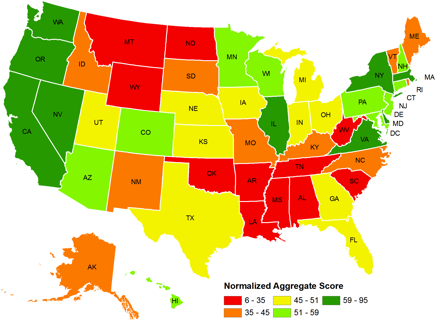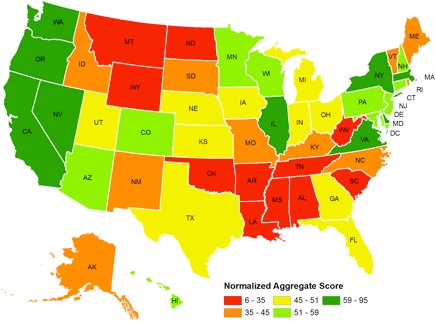 Index of economic impact of transportation (red = worst, green = best)University of ConnecticutWith President Obama’s call earlier this week for $50 billion in spending on transportation infrastructure, the alliterative trio of roads, rail, and runways are in the news again, and the political jockeying has begun.
Index of economic impact of transportation (red = worst, green = best)University of ConnecticutWith President Obama’s call earlier this week for $50 billion in spending on transportation infrastructure, the alliterative trio of roads, rail, and runways are in the news again, and the political jockeying has begun.
Let’s say the president gets what he’s asking for. What should we buy with all that money?
Presumably, we want to buy mobility. That’s the function of a transportation system — to provide the mechanisms and conduits that allow a society’s citizens to get around. But in this country, we’ve had a limited and flawed view of the best way to achieve that.
Fasten your seatbelts, this is going to get a little wonky. But it’s worth it.
One of the chief measurements of how well a region’s transportation system works has for years been the Urban Mobility Report from the Texas Transportation Institute. The UMR has been used to justify billions of spending on ever-wider roads and ever-more-extensive highway systems.
A couple of weeks ago, the think tank CEOs for Cities released a devastating critique of the UMR methodology. Entitled Driven Apart, the report concluded that the UMR’s method of measuring travel delays — which focuses on time spent stuck in traffic rather than overall travel time — fails to take into account the advantages enjoyed by commuters in more densely populated cities with better public transit. In other words, the UMR makes commuting in sprawl look a whole lot more appealing than it is in real life. And it has been used to justify more and more of that sprawl.
From Driven Apart:
Our detailed analysis of the methodology of the Urban Mobility Report suggests that it is an unreliable guide to understanding the nature and extent of transportation problems in the nation’s metropolitan areas.
The Urban Mobility Report’s key measure — the Travel Time Index — is a poor guide to policy, and its speed and fuel economy estimates are flawed. In the aggregate, the analysis appears to overstate the costs of traffic congestion three-fold and ignores the larger transportation costs associated with sprawl.
The CEOs for Cities report sent transportation nerds into a tizzy. You can read some excellent analysis of its implications at Streetsblog (full disclosure: I used to work there).
But at least one researcher in the field suggested that the critique didn’t go far enough.
Writing on Planetizen, Norman Garrick of the University of Connecticut said that we have been going about transportation planning wrong for generations:
Over 50 years ago, Lewis Mumford posed the question “What is transportation for?” Mumford felt that if we had asked this simple question at the start of the interstate era, we might not have committed billions of dollars to the creation of what he called a monochromatic transportation system. In his view, we supported highways to the detriment of transit and cities, mainly because transportation began to be seen as end in itself — rather than a means to an end. We lost sight of the fact that a transportation system affects almost all aspects of daily life and that its value should not be judged purely on the basis of how well it affords the easy movement of vehicles.
Garrick and his colleagues have been working on a different standard by which to judge the quality of transportation systems, the Transportation Index for Sustainable Places. It takes into account a number of different factors — including how those systems contribute to the economic well-being of a community. Here are four of the criteria they used to determine a region’s transportation health:
- transportation is affordable for individuals
- transportation system provides efficient movement of people and goods for economic activity
- transportation finance is locally self-sufficient
- transportation system does not contribute to economic vulnerability of society
What they found is that states with the least “monochromatic” systems — those that had good public transportation and denser development — ranked higher than those who depended heavily on roads. Not only that, their transportation systems were more financially self-sufficient and their citizens had much lower transportation costs:
On this map, the best-performing state is New York, and the worst is Mississippi. The differences between the states are stark — for example, in New York only 21 percent of the average household income is spent on transportation, while in Mississippi transportation eats up a crushing 41 percent of the average household income. In New York only 1% of the state’s GDP is spent on transportation fuel, while Mississippi devotes almost 5 percent of its state GDP to the purchasing of transportation fuel.
In addition, New York State is much less dependent on the federal government to support its total transportation budget — only 15 percent of its budget comes from the federal purse while Mississippi depends on the federal government to provide a whopping 41percent of total transportation budget. But perhaps more telling is the fact that in New York State, over a 10-year period, the GDP grew at a rate 3 times faster than the growth in vehicle miles travelled. In Mississippi we actually had the perverse situation in which vehicle miles grew at a rate three times faster than the rate of growth in GDP.
(In an aside, Garrick also notes similarities between his map showing “monochromatic” transportation states and the map that shows obesity levels in the United States.)
Many legislators, especially in the Republican Party, seem determined to finance highways at the cost of all else. We wrote a couple of weeks ago about Republican gubernatorial candidates and their resistance to financing high-speed rail connections between American cities. They’d rather spend the money on roads. Gov. Chris Christie (R-N.J.) single-handedly scuttled the ARC tunnel under the Hudson River, one of the largest public transit projects in American history (although now he has condescended to reconsider) because he wants to spend money on his state’s roads instead.
This stubborn resistance to public transportation flies in the face of economic reality.
Home prices in New York suburbs with direct train commutes to the city have rebounded much better than suburbs farther out. Readers of NJBiz.com, a business publication that is anything but left-leaning, were highly critical of Christie’s decision to halt work on the ARC tunnel. Research suggests that funding mass transit produces dramatically more jobs than funding roads. And a poll by Transportation for America, a group lobbying for reform of the nation’s transportation system, shows that a majority of Americans want to see more financing for public transit.
There is a desperate need for more transportation options in this country. Whether politicians are willing to face that reality is another story.



